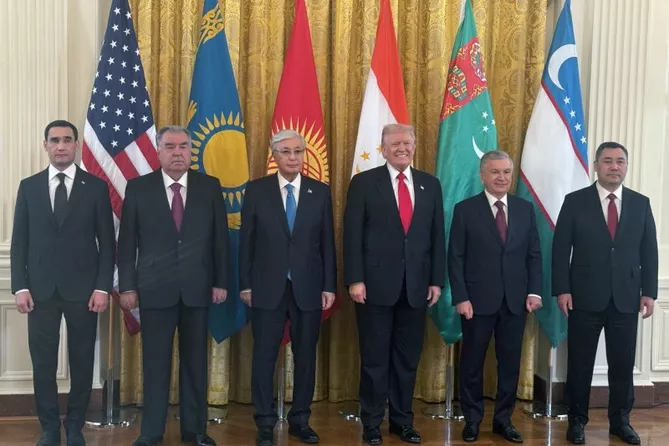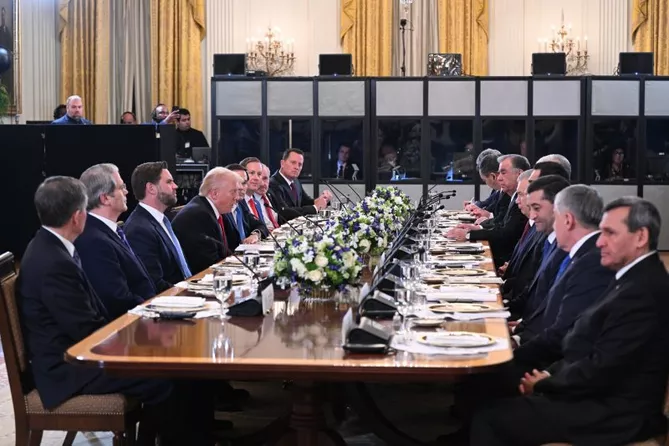
@iStock
The recent U.S.-Central Asia summit in Washington has quickly become one of the most discussed geopolitical events of the season, signaling what many analysts now call the beginning of a new era in American engagement with the heart of Eurasia.
The tone was set by President Donald Trump’s characteristically bold statement in the Oval Office: “There are no leaders stronger and smarter than those we welcome today.” With that, Trump captured the attention not only of his guests - the presidents of Kazakhstan, Uzbekistan, Turkmenistan, Kyrgyzstan, and Tajikistan - but also of global observers long accustomed to Washington’s relative neglect of the region.

Photo credit: Emomali Rahmon. Facebook
Trump’s message was clear: the era of viewing Central Asia as a secondary geopolitical space is over. He described the region as “one of the world’s most remarkable zones,” rich not only in natural resources but also in strategic potential. He also criticized previous U.S. administrations for failing to recognize its importance. Now, under his leadership, Washington intends to strengthen its partnerships with Central Asian nations “more firmly than ever before.”
This newfound attention was warmly welcomed by regional leaders. Uzbekistan’s President Shavkat Mirziyoyev publicly echoed Trump’s words, stating that no previous U.S. administration had shown such respect and genuine interest toward Central Asia. “We all felt a special attitude from President Trump,” he said, “and that means a great deal to all of us.” Mirziyoyev proposed creating a permanent secretariat for the C5+1 framework and suggested that the next “Summit for Peace” be held in Samarkand, a symbolic gesture from a country that has long sought to position itself as a bridge between East and West.
Tajikistan’s President Emomali Rahmon went further, calling Trump’s recent diplomatic initiatives “outstanding” and vital for ensuring global peace and stability in conflict-prone regions. He highlighted the urgent need for closer cooperation on counterterrorism, border security, and drug trafficking.
Rahmon also reminded participants that Tajikistan controls around 60% of Central Asia’s water resources - a crucial geopolitical factor - and possesses significant deposits of rare-earth metals, placing the country at the center of future energy and technology supply chains.

Source: Emomali Rahmon. Facebook
The summit produced tangible results. Tashkent and Washington signed a landmark $135 billion trade and economic agreement, which includes joint exploration of rare-earth deposits.
Meanwhile, Kazakhstan’s President Kassym-Jomart Tokayev announced over $17 billion in new business agreements between American and Kazakh companies. He encouraged U.S. investors to make greater use of the country’s favorable business environment, assuring them of his personal commitment to supporting foreign capital.

Photo credit: Emomali Rahmon. Facebook
Tokayev emphasized that the partnership between Kazakhstan and the United States extends far beyond traditional sectors such as oil and gas. It now encompasses critical minerals, renewable energy, digital innovation, artificial intelligence, and education. He also thanked President Trump for his consistent support in developing what he described as “a truly multifaceted relationship.”
Among the summit’s most notable agreements was the deal between Kazakhstan’s Tau-Ken Samruk and the U.S. investment firm Cove Capital to jointly develop two of the world’s largest tungsten deposits - Severny Katpar and Verkhne Kairakty. The investment, valued at $1.1 billion, could turn Kazakhstan into one of the main global suppliers of this critical material. The project coincides with the launch of the Development Bank of Kazakhstan’s new program (2025-2030) aimed at financing mining and processing projects for rare-earth and critical minerals. Analysts believe these initiatives reflect the U.S. administration’s broader strategy to diversify global mineral supply chains and reduce dependence on China.
Another critical aspect of the Washington discussions was the shared support of both Astana and Washington for the so-called “Trump Route,” or TRIPP - an initiative intended to accelerate the development of the Trans-Caspian International Transport Corridor, also known as the Middle Corridor. This route, stretching from China through Central Asia and the Caspian Sea to Europe, represents a key strategic alternative to Russian-controlled and Chinese-dominated trade paths. If successfully developed, it could reshape the logistics of Eurasian trade, giving Central Asia unprecedented connectivity and economic leverage.
An unexpected but highly symbolic element of the summit was a joint phone conversation between Presidents Trump, Tokayev, and Israeli Prime Minister Benjamin Netanyahu. The discussion centered on Kazakhstan’s potential accession to the Abraham Accords - Trump’s landmark Middle East peace initiative. Tokayev expressed Astana’s readiness to join the process, describing it as a contribution to global dialogue, the reduction of confrontation, and the advancement of international law in accordance with the UN Charter. Trump called the move “a significant step forward in building bridges across the world,” reinforcing the impression that his diplomatic vision is expanding far beyond traditional geographic boundaries.
The joint statement adopted at the end of the summit reaffirmed the strategic importance of the Trans-Caspian corridor, the strengthening of supply-chain resilience, and the deepening of regional economic cooperation. Both sides underscored their commitment to sustainable development, innovation, and regional prosperity - goals that align closely with the long-term vision of each participating nation.

Photo credit: Emomali Rahmon. Facebook
On Truth Social, Trump later wrote that hosting the Central Asian leaders at the White House was “a great honor” and described the summit as “a powerful step toward strengthening the strategic partnership between the United States and this remarkable region.” His words resonated as a clear declaration that Washington is reclaiming its role as an active player in Eurasia’s complex geopolitical landscape.
For years, U.S. involvement in Central Asia has been marked by hesitation and inconsistency, often overshadowed by Russian influence and China's growing economic presence. The latest summit suggests that this dynamic may be shifting.
Trump’s rhetoric, backed by concrete agreements and a vision of shared growth, projects a sense of renewed American confidence. For the Central Asian republics, it represents a rare opportunity to diversify partnerships, attract new investment, and assert greater agency in their foreign-policy choices.
Ultimately, this summit was about more than diplomacy - it was about redefining how Central Asia fits into the emerging world order. Trump’s “America Reconnected” approach signals a deliberate effort to rebuild strategic trust and to ensure that the region’s vast resources, transport routes, and human capital are integrated into a broader, balanced global framework.
If the commitments made in Washington are followed through, the meeting could indeed mark the start of what Trump described as “a new era of relations” between the United States and Central Asia - one based on mutual respect, practical cooperation, and a shared belief that stability and prosperity in the heart of Eurasia serve not just regional interests, but the world’s collective future.
Share on social media